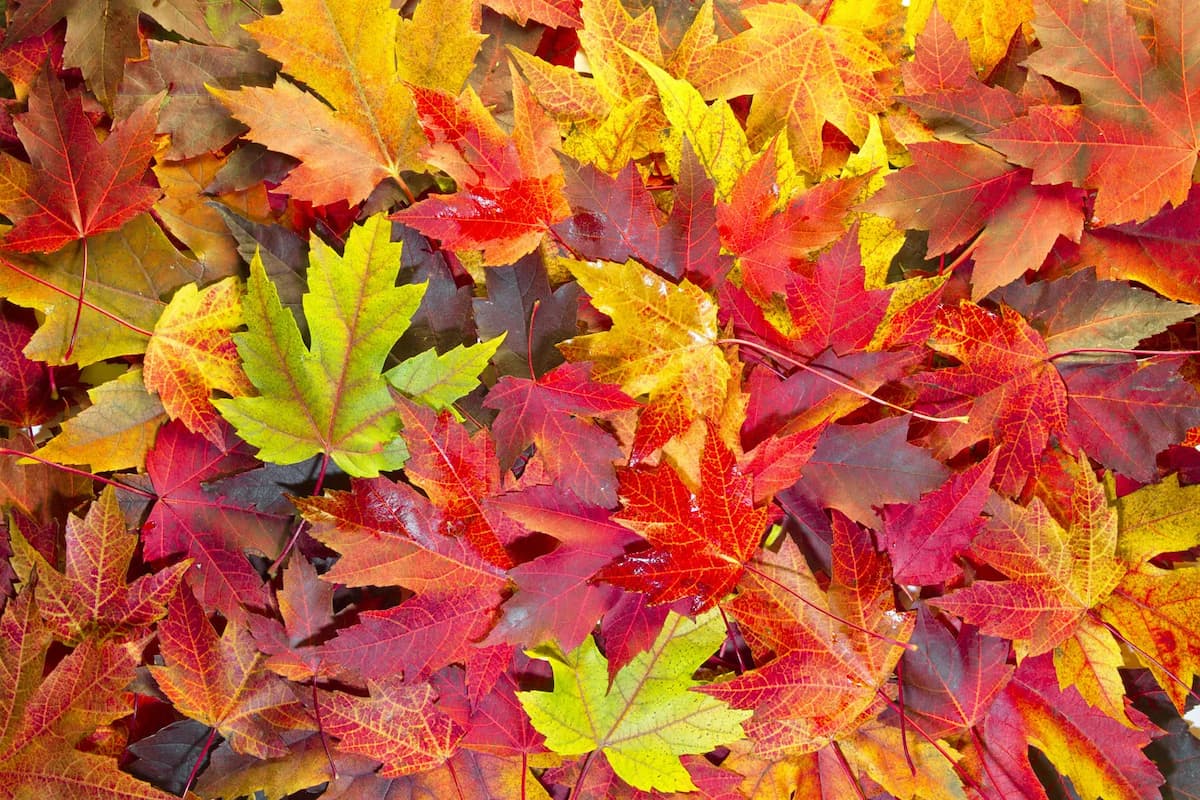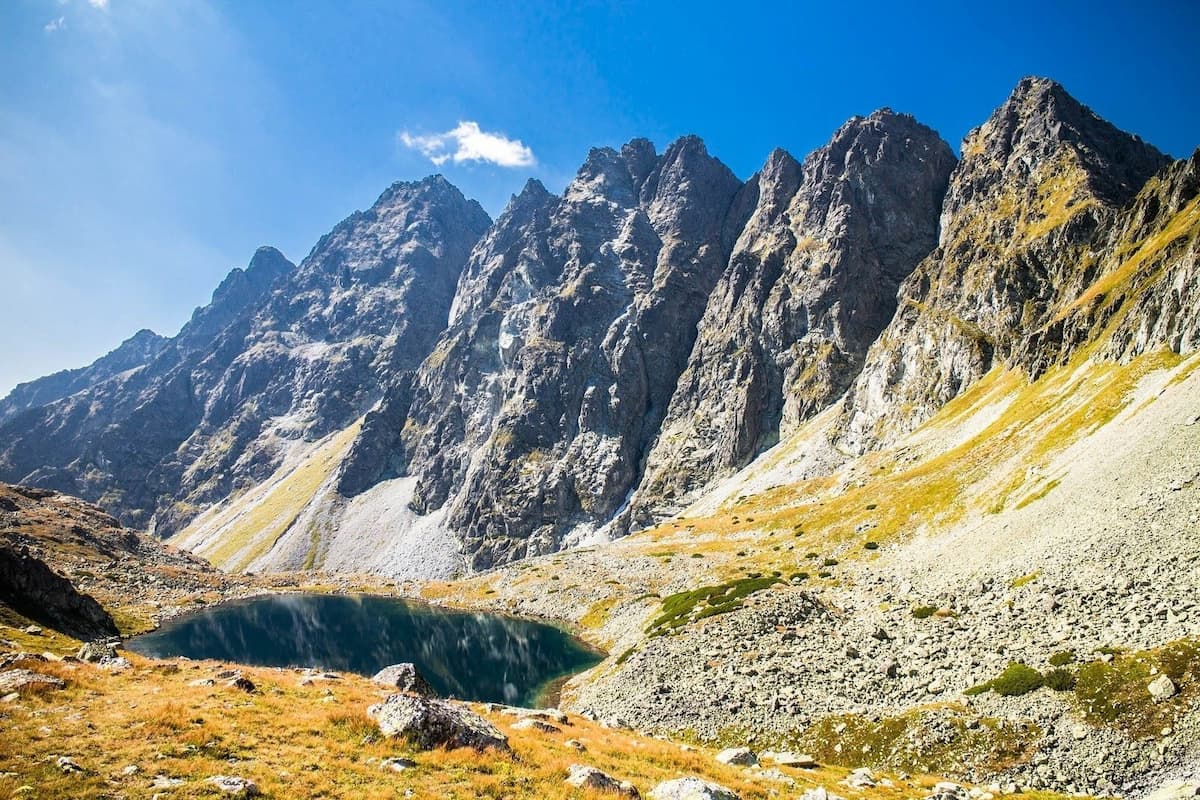Need some classical music about autumn and the fall season to add to your playlist? We’ve got you covered!

© Davidgn/Dreamstime.com
Today, we’re looking at almost four centuries of music. So grab a pumpkin spice latte, settle in, and enjoy these thirty pieces of classical music about autumn.
The 4 Seasons by Christopher Simpson (ca 1640s)
Christopher Simpson was an English composer and virtuoso viol player. (Viol instruments were predecessors to modern string instruments.)
Simpson wrote his Four Seasons for a treble instrument, two bass viols, and continuo. In each one, he included a fantasy, an air, and a galliard (a type of energetic dance).
Players also added their own ornamentation to the work to customize their interpretations.
Autumn from the Four Seasons by Antonio Vivaldi (1724)
Let’s be honest…you knew this work would be on the list!
In 1724, composer and violinist Antonio Vivaldi wrote a set of violin concertos inspired by each of the four seasons.
He also included poetry in the score to describe in words what he was describing in music.
His autumn concerto portrays harvest celebrations and hunting parties.
Autumn from The Seasons by Joseph Haydn (1801)
Put in modern movie terms, The Seasons was a bit of a cash-grab sequel to Haydn’s wildly popular oratorio The Creation.
Unfortunately, like many sequels, it wasn’t as successful as the work that inspired it, but it’s still worth enjoying today.
The forces required to mount The Seasons include a large orchestra, a chorus, and three vocal soloists.
Like Vivaldi, Haydn chose to highlight harvest celebrations and hunting parties. The hunting chorus is one of the best of its era.
October from Das Jahr (The Year) by Fanny Mendelssohn Hensel (1841)
Fanny Mendelssohn Hensel was composer Felix Mendessohn’s older sister, as well as a brilliant pianist and astonishingly productive composer.
Because she was a woman, many of her works never entered the standard repertoire in the way that her brothers did. Luckily for listeners, that’s beginning to change.
Das Jahr (The Year) is a set of piano pieces that trace the year month-by-month.
In a clever twist on the autumnal hunting motif, Hensel’s October’s piece features horn calls that turn out to be traveling minstrels. The deer in the forest may be startled, but the work ends with a happy flourish.
In Autumn by Edvard Grieg (1865)
Norwegian composer Edvard Grieg was 22 when he wrote this overture. A fellow composer friend told him, “This is trash, Grieg; go home and write something better.”
So Grieg transcribed it for two pianos and submitted it to a composing competition…and that critical composer friend just happened to be on the jury! Amusingly, In Autumn ended up winning first prize.
E.Grieg Concert Overture “In Autumn” op.11 for piano 4 hands
Autumn Song by Pyotr Ilyich Tchaikovsky (1876)
In the 1870s, Tchaikovsky had the same idea as Fanny Mendelssohn Hensel: writing a series of piano works, one inspired by each month.
His October song begins with a snippet of poetry:
Autumn, our poor garden is all falling down,
the yellowed leaves are flying in the wind.
The music itself is a wistful, lovely sigh for solo piano, with the melancholy that is brought on by the season in full display. Anyone who has lived in a northern climate can relate!
Symphony No. 10: “To Autumntime” by Joseph Joachim Raff (1879)
Joachim Raff was born in 1822 in Switzerland.
He worked with many of the big names of Romantic music (including Mendelssohn, Liszt, and Clara Schumann) and was widely acclaimed in his own time, but is rarely heard today.
This symphony has four movements, and each was published with subtitles:
I. Impressions & Feelings
II. Ghostly Round-Dance
III. Elegie
IV. Men Hunting
“Pensée d’automne” by Jules Massenet (1887)
In the song Pensée d’automne, or Thoughts in Autumn, composer Jules Massenet set a poem by French poet Armand Silvestre to music.
The poem speaks of “grieving birds” and “withered flower cups.” The narrator wistfully invites a lover to return to the place where they courted in the springtime.
He then points out that his love for her has made the season irrelevant:
Let the beautiful days die! Let the harsh winter be born again!
Like a joyful hymn in the moaning wind,
A song of love emerges from my devoted heart!
Autumn: Etude de Concert No. 2, Op. 35 by Cécile Chaminade (1886)
French composer Cécile Chaminade was one of the most popular composers of her era. She focused primarily on writing piano music and miniatures. They proved to be especially popular in the domestic sheet music market.
That popularity, combined with her sentimental romantic style as well as her gender, led her to be dismissed as an unserious artist.
This autumn-inspired etude challenges that assumption. It’s both achingly tender and technically challenging.
8 Characteristic Pieces, En Automne, by Moritz Moszkowski (1886)
Moritz Moszkowski was a German pianist and composer of Polish origin. Although his work is rarely seen on programs today, he was very popular during his lifetime.
This work, from his set of eight Characteristic Pieces, seems to portray a chilly wind blowing leaves off the trees in colored swirls.
Four Sketches, op. 15: In Autumn by Amy Beach (1892)
Amy Beach was a profoundly talented American composer and pianist. She began writing little waltzes for piano when she was only four years old.
After she got married at the age of eighteen, she focused on composition because it wasn’t seemly for a respectable wife of a doctor to tour as a piano soloist.
In 1892’s Four Sketches, written when she was twenty-five, a snippet of poetry appears at the “In Autumn” movement: “yellowing foliage on scattered lawns.” This is a quote from French poet and statesman Alphonse de Lamartine.
Woodland Sketches, Autumn, by Edward MacDowell (1895)
One of Beach’s colleagues was composer Edward MacDowell.
His most famous work is likely To a Wild Rose, which is the first piece in his Woodland Sketches.
The Sketches were inspired by the time that MacDowell spent in the New Hampshire countryside after he and his wife bought a summer house there.
Every morning, he would write a little piano sketch and then throw it away. Luckily his wife caught him and encouraged him to take To a Wild Rose out of the trash and publish it. The nine other sketches – including Autumn – followed.
Autumn from The Seasons by Alexander Glazunov (1899)
In the late 1890s, Russian composer Alexander Glazunov and a fellow composer friend named Riccardo Drigo were each hired to write a ballet score. However, Glazunov found himself more inspired by Drigo’s assigned subject matter – the seasons! – and Drigo was inspired by Glazunov’s. They solved their problem by switching assignments.
During the Autumn portion of the ballet, dancers take part in a triumphant “autumn bacchanale” while leaves fall on them.
Five Songs: Höstkväll (Autumn Evening) by Jean Sibelius (1904)
Between 1903 and 1904, Finnish composer Jean Sibelius wrote a set of five songs. The cycle began with this stark, mournful description of an autumn evening.
The lyrics were written by Swedish writer Viktor Rydberg, known as “Sweden’s last romantic.”
“The Lonely One in Autumn” from The Song of the Earth by Gustav Mahler (1907)
Gustav Mahler’s Das Lied von der Erde (“The Song of the Earth” in English) is a haunting work for two voices and orchestra. It was inspired by a German paraphrase of classical Chinese poetry.
The second movement is a restless, long-phrased marvel. Its poetic inspiration comes from a poem mourning the seasonal death of beauty.
“I weep much in my solitude,” the narrator sings, after describing frosty grass, cold wind, and wilted leaves. “The autumn in my heart has lasted too long.”
Préludes, Book II: 2. Feuilles mortes (Dead Leaves) by Claude Debussy (1912-13)
French composer Claude Debussy wrote two books of twelve préludes each, for a grand total of twenty-four.
Some have descriptors attached, such as The Girl with the Flaxen Hair or Canopic Jars.
The second is titled “Feuilles mortes” or “dead leaves.”
The harmonies are not attached to any one key, making them feel restless and unsettled…and perhaps a little ominous. It is a fitting evocation of the moment before winter strikes.
Autumn from North Country Sketches by Frederick Delius (1913-14)
English composer Frederick Delius was, like many of his musical countrymen, deeply inspired by the British landscape.
He composed this dreamy, desolate portrait of the Yorkshire moors on the eve of World War I.
Symphony No. 4 “Løvfald” (Fall of the Leaf) by Rued Langgaard (1916)
Danish composer Rued Langgaard (born in 1893 in Copenhagen) was an overachiever as a child. His first symphony was played by the Berlin Philharmonic when he was just eighteen!
By 1916, the year he turned 23, he was already writing his majestic fourth symphony, which he bestowed with the subtitle Løvfald (“Fall of the Leaf”). There are undeniable elements of Richard Strauss and Richard Wagner here.
Unfortunately, although he continued composing for the rest of his life, Langgaard’s music never found a foothold in the repertoire.
Comes Autumn Time, by Leo Sowerby (1916)
Leo Sowerby was a major figure in twentieth-century American church music. He even won the Pulitzer Prize in 1946.
The idea of Comes Autumn Time originated after Sowerby read a poem named Autumn by Canadian poet Bliss Carman. It includes the lines:
Now when the time of fruit and grain is come
When apples hang above the orchard wall,
And from the tangle by the roadside stream
A scent of wild grapes fills the racy air…
The work began as an organ piece that premiered at the Fourth Presbyterian Church in Chicago. Listeners loved it so much that Sowerby made a transcription for orchestra.
November Woods by Arnold Bax (1917)
There’s a naughty story behind British composer Arnold Bax’s tone poem November Woods.
In 1914, the 31-year-old Bax (who was married) fell in love with brilliant 19-year-old pianist Harriet Cohen. The two would carry on their affair for decades.
While Bax denied any specific programmatic interpretation of November Woods, it is clear that something about the turbulence of these years found its way into the work.
“If there are sounds in the music which recall the screaming of the wind and the cracking of strained branches, I hope they may suggest deeper things than these at the same time,” he wrote in a letter. “The middle part may be taken as a dream of happier days, such as may sometimes come in the intervals of stress, either physical or mental.”
In Autumn, by Frank Bridge (1924)
British composer Frank Bridge wrote this alternately sparse and thorny piano work in 1924.
It consists of two movements. The first is titled “Retrospect” and the second “Through the Eaves.”
The Fall of the Leaf by Gerald Finzi (1929–1942)
English composer Gerald Finzi spent a long time tweaking the details of this elegy. (He never did get around to orchestrating it.)
He imagined it as the finale of a chamber symphony, but that chamber symphony never materialized, and this is all we have.
The work is, by turns, withdrawn and triumphant but always measured and majestic.
The title The Fall of the Leaf came from a dance found in the Fitzwilliam Virginal Book, a famous British book of Elizabethan keyboard music dating from the sixteenth and early seventeenth centuries.
Four Last Songs, September by Richard Strauss (1948)
German composer Richard Strauss capped off a decades-long career by writing Four Last Songs for soprano and orchestra. He was eighty-four when he wrote them, and they were his final finished work.
Strauss was inspired by poet Hermann Hesse and for the second song, September, set his poem by the same name.
Hesse’s poem speaks eloquently of the departing summer season. “Summer smiles,” the soloist sings, “astonished and weak, in the dying garden dream.”
Folk Songs of the Four Seasons, Autumn by Ralph Vaughan Williams (1949)
English composer Ralph Vaughan Williams wrote Folk Songs of the Four Seasons in 1949.
It was commissioned by the Women’s Institute for a festival. At the premiere the following year, 3000 women sang in the chorus at Royal Albert Hall!
The work drew on British folk tunes that Vaughan Williams had collected throughout his life.
Autumn from The Four Seasons of Buenos Aires by Astor Piazzolla (1969)
Over the course of a decade-plus, Argentine composer Astor Piazzolla wrote a series of tangos that he later turned into The Four Seasons of Buenos Aires.
These works were originally written for Piazzolla’s tango quintet ensemble. Then, in the 1990s, Ukrainian composer Leonid Desyatnikov reimagined them as works for chamber orchestra and virtuoso solo violin. He also added a few cheeky references to Vivaldi’s Four Seasons, and a violin classic was born.
Études: Automne à Varsovie by György Ligeti (1985)
Over the course of his career, Hungarian composer György Ligeti wrote three books and eighteen etudes for solo piano.
This etude comes from his first book. It is subtitled Automne à Varsovie or “Autumn in Warsaw.”
This is a reference to the contemporary music festival Warsaw Autumn, which seeks to foster the performance of new music from not just Poland but all around the world.
The etude is dedicated to Ligeti’s Polish friends.
Autumn from The Seasons by Thea Musgrave (1988)
In 1988, Scottish composer Thea Musgrave was commissioned by the Academy of St. Martin in the Fields to write The Seasons.
In this work, Musgrave conceives of the seasons as not just literal but metaphorical:
In Autumn, we have the approaching storm and, on the ground, a grim battle for life. The fire drives all before it and they confront each other in a vicious bloody conflict. In the music, hunting horns have a prominent part while behind it all is restless.
Autumn Music by Jennifer Higdon (1995)
The composer herself wrote a lovely program note about this work for woodwind quintet:
The first part of the quintet represents the beginning of the season, with its explosions of color, sharp lines, and vivid imagery; always changing and always vibrant. The musical lines are sometimes present with each instrument carrying a different rhythm, reminiscent of the way leaves float down from a tree in a very unsynchronized manner. As the quintet moves into the last part of the work, there is more of an introspective and melancholy quality to the music; the music itself becomes more simplified, with a darker color to the sound. It is the passing of the season.
Autumn Gardens by Einojuhani Rautavaara (1999)
Finnish composer Einojuhani Rautavaara wrote the mystical-sounding Autumn Gardens for orchestra in 1999.
It has since become one of his best-known works.
He wrote in the program notes for it:
I have often compared composing to gardening. In both processes, one observes and controls organic growth rather than constructing or assembling existing components and elements. I would also like to think that my compositions are rather like ‘English gardens’, freely growing and organic, as opposed to those that are pruned to geometric precision and severity.
Four Seasons Recomposed by Max Richter (2012)
Recomposed was written by German-born British composer Max Richter in 2012.
The work originated after Richter thought about how overfamiliar many listeners are with Vivaldi’s omnipresent Four Seasons.
So he decided to create a work inspired by Vivaldi’s, taking elements from the original concertos and creating new music around them. His hope was that musicians would then hear these familiar works with new ears.
“We hear it everywhere — when you’re on hold, you hear it in the shopping center, in advertising; it’s everywhere. For me, the record and the project are trying to reclaim the piece, to fall in love with it again,” Richter told NPR in 2012.
Conclusion
As we’ve seen, so much classical music brilliantly captures the many moods of autumn.
From Vivaldi’s lilting Four Seasons to Tchaikovsky’s melancholy “Autumn Song” to Musgrave’s grim fall hunt, classical music evokes the complex emotions brought about by the season in a way that no other art form can.
For more of the best in classical music, sign up for our E-Newsletter



I am incredibly surprised. I know many. I have many. But to collect them here is very impressive. I dont think any is missing!